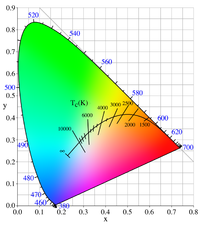
Photo from wikipedia
Abstract In the framework of the European material development programme for fusion power plants beyond the international thermonuclear experimental reactor (ITER), tungsten (W) is an attractive candidate as plasma facing… Click to show full abstract
Abstract In the framework of the European material development programme for fusion power plants beyond the international thermonuclear experimental reactor (ITER), tungsten (W) is an attractive candidate as plasma facing material for future fusion reactors. The selection of tungsten is owing to its physical properties such as the high melting point of 3420 °C, the high strength and thermal conductivity, the low thermal expansion and low erosion rate. Disadvantages are the low ductility and fracture toughness at room temperature, low oxidation resistance, and the manufacturing by mechanical machining such as milling and turning, because it is extremely cost and time intensive. Powder Injection Molding (PIM) as near-net-shape technology allows the mass production of complex parts, the direct joining of different materials and the development and manufacturing of composite and prototype materials presenting an interesting alternative process route to conventional manufacturing technologies. With its high precision, the PIM process offers the advantage of reduced costs compared to conventional machining. Isotropic materials, good thermal shock resistance, and high shape complexity are typical properties of PIM tungsten. This contribution describes the fabrication of tungsten monoblocks, in particular for applications in divertor components, via PIM. The assembly to a component (mock-up) was done by Hot Radial Pressing (HRP). Furthermore, this component was characterized by High Heat Flux (HHF) tests at GLADIS and at JUDITH 2, and achieved 1300 cycles @ 20 MW/m². Post mortem analyses were performed quantifying and qualifying the occurring damage by metallographic and microscopical means. The crystallographic texture was analysed by EBSD measurements. No change in microstructure during testing was observed.
Journal Title: Nuclear Materials and Energy
Year Published: 2019
Link to full text (if available)
Share on Social Media: Sign Up to like & get
recommendations!